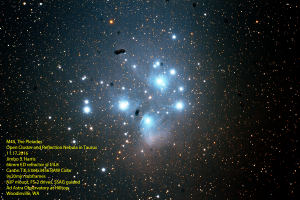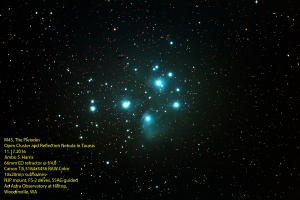Well, it’s been awhile since I’ve been out in the observatory. I pulled the camera in favor of an eyepiece at one point, and just never really got back to putting the scope back together. Then it got a little rainy…
In any case, tonight was the first of the “clear and cold” nights that seem to happen on either side of the Winter Solstice. With a waning gibbous moon not yet risen (the “super moon” was just a couple nights ago — it’s so hard to explain to people that it’s not as obvious as you’d think), I got the mount booted up around 7:30. Gotta love long winter nights.
The camera went back on with no problems; I really like the Bahtinov mask for quick focusing.
And everything else worked just as smoothly as I’ve come to expect — guiding under 1″ all night, ripping down 4 hours of 20-min subframes, like it was easy or something. Someday, remind me to list all the things that have to go “right” in order for a 20m image to work with a rotating sky.
Anyway, I decided to go easy on myself, and picked a target I can easily see in the finder, M45. I really enjoy that “The Family” (as we call it here at Hilltop O) is in the sky during the holidays.
It’s an open cluster of stars, meaning that they are all related to each other, and were born in the same nebula, so it’s not just a chance alignment that we see them close to each other in the sky.
The blue nebulosity is a reflection nebula; the stars are passing by an interstellar dust cloud, and we see their light reflected off of the dust and gas. It appears blue for the same reason that the sky looks blue; the short, blue wavelengths of light scatter most.
This is different than the red/pink emission nebulae, which are clouds of hydrogen that are glowing for the same reason a neon light glows; lots of energy input makes the gas throw off photons of particular wavelengths.
Anyway, I think that the blue wisps make this already pretty cluster even more beautiful. You gotta love The Pleiades; they look great naked eye, amazing with any size telescope, and even better with a long exposure.
Even the 30sec subframe I used to ensure focus was OK had some nebulosity in it; the 5m shot had even more. I swear I should just start with the 20m shots and be done with it. 🙂
The raw frames looked pretty good at 20m, lots of cloudy nebulosity. There are a ton of dust bunnies on the optics (that’s the black specks all over the image) — I need to clean the scope and the camera and also figure out how to do flat frames. And autofocus. And get plate solving really solid. And bring dome controls to the control desk. OK, so I have a to-do list.
Anyway, here’s the result of the evening’s deployment.

The long integration time means lots of deep details. I threw away an hour of images because the moon came up during the run; so this is “only” 3 hours. The image could stand more cleanup. But it’s been awhile, and I’m happy. Time for bed.
Edit 2/2/2017 – I re-processed this photo with flats applied to hopefully remove the dust bunnies. It got the worst of them.


MOST COMMENTED
Observatory
Observatory 2.0 – Time has come today!
General / Maintenance
First Light, a deeper look
Mount / Observatory / Telescope
Observatory 2.0 – Result!
Observatory
Observatory 2.0 – The Pier goes in
Gear / General / Maintenance
Martin Farmer Wormblock installation notes
Deep Sky / Long Exposure Photography
NGC2244, The Rosette Nebula
Deep Sky / Long Exposure Photography
Another beautiful night.